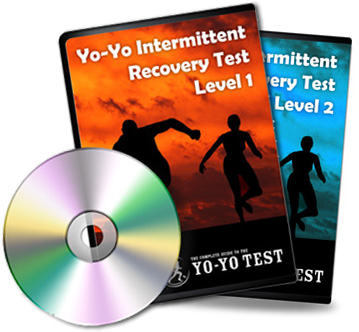How to Conduct the Yo-Yo Fitness Test
There are six official versions of the yo-yo test, the endurance test is a 20m shuttle test like the beep test (no rest periods), and the intermittent test versions have rest periods of 5 seconds (intermittent endurance test) or 10 seconds (intermittent recovery test) between each 40m shuttle. For each of these are two levels: level-1 designed for lesser trained individuals and level-2 aimed at well-trained and elite athletes and starting at a faster speed. All test variations have increasing speeds throughout the test.
The procedure described below applies to all versions, there are pages with more detailed instructions and a list of resources for each of the test versions.
See the specific procedures for each version:
- Yo-Yo Intermittent Recovery Test Level 1
- Yo-Yo Intermittent Recovery Test Level 2
- Yo-Yo Intermittent Endurance Test Level 1
- Yo-Yo Intermittent Endurance Test Level 2
- Yo-Yo Endurance Test Level 1
- Yo-Yo Endurance Test Level 2
Equipment Required: (see more)
- Flat, non-slip surface, at least 30m long, and an appropriate width based on the number of participants.
- measuring tape of at least 20 meters.
- marker cones.
- audio cd or mp3.
- cd or mp3 player.
- loud speakers.
- recording sheets and pen.
Course layout: Cones or tape is used to mark out the desired course. For the endurance test, only two lines are required, 20 meters apart. For the intermittent versions, three parallel lines are needed, two 20 meters apart, and another line another 2.5m (endurance version) or 5m (recovery version) away from the starting end.

Preparations: Make sure the participants are adequately prepared: well-rested, hydrated and fueled, and familiar with the test procedure and motivated to perform maximally. (see preparing for the yo-yo test for more details). Give clear and standardized instructions about the test and what is expected of them (see an example instruction), including the importance of keeping in time to the recording and completing the full 20m run.
Starting the Test: All participants should line up along the starting line. The athletes start with a foot behind the starting line, and begin running when instructed by the audio recording. The athlete turns when signaled by the recorded audio beep at the line 20 meters away, and returns to the starting point. For the endurance test, the athletes continue running in time with the audio signals with no rest period. For the intermittent tests, they walk or jog to the next line and back to come to a complete stop at the starting line again, before starting off with indicated.
During the test: For the intermittent tests, there is an active recovery period of 5 or 10 seconds between every 40 meters run, during which the subject must walk or jog to the next line and return to the starting point. Participants should come to a complete stop before starting the next 40m run - rolling start is to be avoided. At regular intervals, the running speed will increase, as indicated on the recording. You can see the tables with details of the speeds and distances for each test.
Finishing the test: The participants must continue for as long as they can. Some of the athletes will choose to stop when they have reached their physical limit. For others, you will need to give a warning as they drop behind the required pace or make one of the errors listed below. On the second infraction you pull them out of the test.
You give a warning when the participant ...
- starts the run before the audio signal.
- does not reach either line before the audio signal.
- turns without touching or going over the line (therefore running short).
- does not come to a complete stop before starting the next 40m run (for the intermittent versions only).
Scoring: the participant's score is the highest level successfully completed. The shuttle at which the participant pulls out or at which the second warning occurs is not counted, e.g. if the second warning occurs at level 16.4, the athlete's score is 16.3. When an athlete voluntarily withdraws before a second warning, the last shuttle completed successfully is their score. There are scoring sheets for each test version to keep track of athlete scores during the test. The score is recorded as either the highest level and shuttle successfully completed, or the total distance covered up to that point. See more about scoring.
Interpretation: You can use the table of norms to work out a fitness rating based on the yo-yo test score. For some versions there is also a yo-yo test calculator to work out VO2max and get a fitness rating.
Cite this Page


